Site pages
Current course
Participants
General
Module 1: Formation of Gully and Ravine
Module 2: Hydrological Parameters Related to Soil ...
Module 3: Soil Erosion Processes and Estimation
Module 4: Vegetative and Structural Measures for E...
Keywords
Lesson 28 Temporary Control Structures
28.1 Introduction
Temporary physical and structural measures such as gully reshaping, brushwood dam, protection by sandbag, loose stone barrier, gabion structures and arc-weir check-dams are used to dissipate the energy of runoff and to keep the gully stable. Check-dams are constructed across the gully bed to stop channel bed erosion. By reducing the original gradient of the gully channel, check-dams reduce the velocity and erosive power of runoff. Run-off during peak flow is conveyed safely by check-dams. The structures can be either temporary or permanent. The choice of the measures and extent of their use will depend on the amount of the runoff and the status of the gully; whether young and actively eroding or mature and stabilizing naturally. Good judgment is required in determining what measures to be used that are both economical as well as effective. Consideration should then be given to the ways of stabilizing the gully head, floor and sidewalls.
An effective sediment and erosion control plan should:
Minimize clearing: use site fingerprinting, buffers and construction phasing.
Prevent off-site runoff from flowing across bare soils: use perimeter dikes and diversions.
Stabilize bare soils on the site: use erosion control mats, planting, retaining walls.
Remove sediment from runoff before it leaves the site: use stabilized construction entrances/exits, silt fences, sediment traps, check dams.
Plan soil disturbance activities for the dry season.
28.2 Check Dam
A check dam, sometimes known as ditch check, is a barrier constructed across waterways such as open channel, swales, and ditch or drains. Check dams retain water behind them that helps the surrounding soil to remain wet for a longer time after the monsoon season is over. Check dam can either be a temporary or a permanent structure, which is built to retain and maintain the desired groundwater level within the peatland. In this way, it reduces the possibility of ignition of fire in the drying peat as well as prevents any fire from spreading during any hot and dry spell. In the context of fire prevention and control, check dams are specifically installed for the following purposes:-
a) To maintain minimum water level in the forest areas so as to avoid any fire ignition on land surfaces.
b) To maintain high soil moisture levels so as to minimize fire in the forest areas from occurring and spreading especially during prolonged dry and hot season
c) To prevent over-drainage of the peat land which will lead to drying out of the organic materials causing carbon release as well as land subsidence.
d) To conserve as much water as possible during the post-monsoon season that would help to recharge ground water.
28.3 Classification of Check Dam
The check dams are classified as:
(1) Temporary check dam
(a) Brushwood dams
(i) one row or single post brush wood dam
(ii) Double row post brush wood dams.
(b) Semi permanent dams
(i) Loose rock dam
(ii) Netting dam
(iii) Log check dam
(2) Permanent check dam
(a) Drop Spillway
(b) Drop inlet spillway
(c) Chute spillway
28.4 Durability of Check Dam
Check dams can be built using various types of materials such as earth, sand (loose or in bags), timber (sawn or log), stones/rocks (loose or stacked), or concrete (precast form). In selection of the most appropriate materials to be used as the main components of the check dam structure, designer should take into consideration the following factors:
Size and dimensions of check dam
Site conditions (e.g. waterlogged, depth of peats)
Accessibility of site
Availability of suitable materials locally
Designed service life of the structure (short-term, medium term or long-term)
Cost of construction
Temporary Check Dam
Temporary check-dams, which have a life-span of three to eight years, collect and hold soil and moisture in the bottom of the gully to give vegetation an opportunity to establish. Runoff control structures may be needed to be commissioned in the gully.
28.5 Gully Reshaping and Filling
Gully wall reshaping involves cutting off steep slopes of active gully flanks into gentle slope (maximum at 45% slope), up to two-third of the total depth of the gully and construction of small trenches along contours for re-vegetating slanted part of the gully walls and beds, as illustrated in Fig. 28.1. If the gully is wide and has meandering nature with huge accumulation of runoff flowing down; cut off soils and soil materials can be washed away by runoff water and requires construction of retaining walls, as illustrated in Fig. 28.2, to protect displaced (not yet stabilized) soils and soil materials and newly created sidewalls of the reshaped gully.
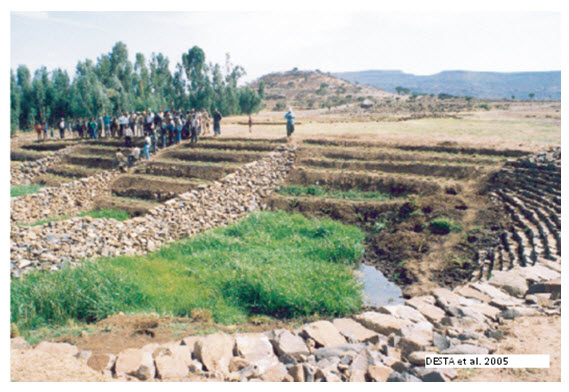
Fig. 28.1. Gully reshaping and filling. (Source: https://energypedia.info/images/a/aa/GullyReshapingRevegetation.png)
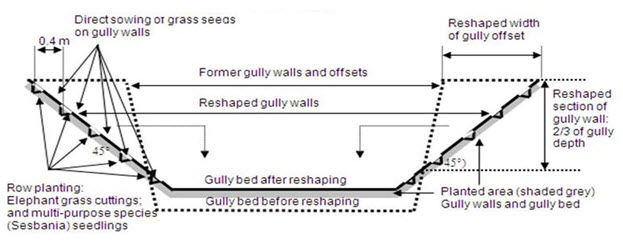
Fig. 28.2. Gully wall reshaping without retention wall. (Source: http://www.bebuffered.com/downloads/ManualonGullyTreatment_TOTFinal_ENTRO_TBIWRDP.pdf)
Gullies with very little water flow can be stabilized by filling and shaping; that is, if the surface water is diverted, and livestock are kept out. Steep gully heads and gully banks should be shaped to a gentler slope (about a one-to-one slope). Filling of gullies is applicable only for small discontinuous gullies, in their early stages of development. The filled gully area can be planted and even be used for cultivation. Rills and incipient branch gullies may be filled in by spade, shovel or plough (on cultivated lands).
The practicability of shaping a gully depends on its size and the amount of fill needed to restore the gully to its desired shape. Steep gully sides can be reshaped. Topsoil should be stockpiled and re-spread over exposed areas to ensure the rapid establishment of vegetation. Annual grass and crops such teff, oats or barley can be used to provide a quick cover. It may be possible to temporarily divert water from the battered gully while grass is establishing.
The common practice of filling gullies with rubbish, logs, rocks, branches, twigs and other materials does very little to solve the problem. In most cases, particularly in gullies that carry copious runoff during the monsoon season, it makes the gully worse particularly if the placement and anchorage of those materials is not done properly.
Generally, in the filling and shaping process the following need to be considered:
The soil should be well compacted
The filling operation should be done before the rains
To protect it from erosion, close growing crops should be planted or seeded immediately
The entire work of shaping and filling should be done in one operation
28.6 Brushwood Check Dam
Brushwood check-dams made up of posts and brushes are placed across the gully, as shown in Fig. 28.3 and 28.4. The main objective of brushwood check-dams is to hold fine materials carried by flowing water in the gully. Small gully heads, no deeper than one meter, can also be stabilized by brushwood checkdams. Brushwood check-dams are temporary structures and should not be used to treat ongoing problems such as concentrated run-off from roads or cultivated fields. They can be employed in connection with land use changes such as reforestation or improved range management until vegetative and slope treatment measures become effective.
The main requirement of temporary gully control structures is that, they must be quick and easy to construct, should be made by using cheap and readily available material in nearby areas.
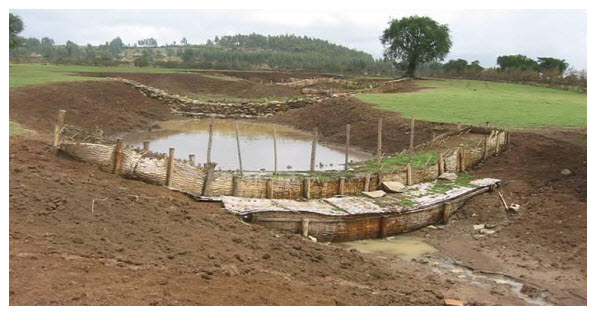
Fig. 28.3. Brushwood check dam. (Source: http://www.bebuffered.com/downloads/ManualonGullyTreatment_TOTFinal_ENTRO_TBIWRDP.pdf)
\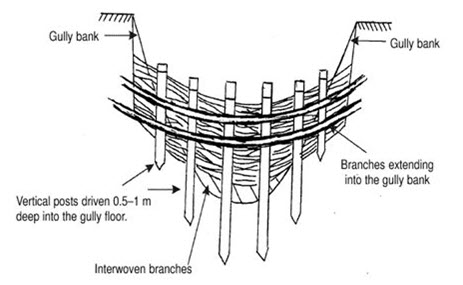
Fig. 28.4. A single row brushwood check-dam front view. (Source: http://www.bebuffered.com/downloads/ManualonGullyTreatment_TOTFinal_ENTRO_TBIWRDP.pdf)
In areas where the soil in the gully is deep enough, brushwood check-dams can be used if proper construction is assured. The gradient of the gully channel may vary from 5 to 12 percent, but the gully catchment area should not be as such huge which produces high amount of runoff volume. There are two types of brushwood check-dams: these are single row and double row brush wood check-dams. The type chosen for a particular site depends on the amount and kind of brush available and on the rate and volume of runoff. The maximum height of the dam is one meter from the ground (effective height).
1. Single Row Brushwood Check-dams
These check-dams can be used where the rate of runoff is less than 0.5 m3/sec. The structure is temporary and its durability will depend on the quality of posts used. If possible live posts of willow, popular and other trees should be used (8-10 cm dia). Flexible branches are cut and woven around the posts. This dam is constructed across the channel or gully with the brush wood materials, laid along the flow of water, keeping the butt ends towards u/s face of the gully, as shown in Fig. 28.5. The brushwood is kept in position by tying to the posts. Before the dam construction is begun, the sides of the gully or channel should be sloped to 1:1 and the gully bed should also be excavated for 15 cm depth along the entire gully width over which brushwood have to be laid. In addition, 15 cm excavation is also done into the bank to give necessary notch capacity.
After excavation, the wooden posts of about 10 cm in diameter are driven in a line across the gully at an interval of 90 cm up to a depth of 75 cm in gully bed. The top of wooden posts should be kept at such a height so as to form a notch of required size. The brushwood is tied from the front line and the other lines are tied using galvanized wire for keeping them in position. The lowest layer of the brushwood must be the longest.
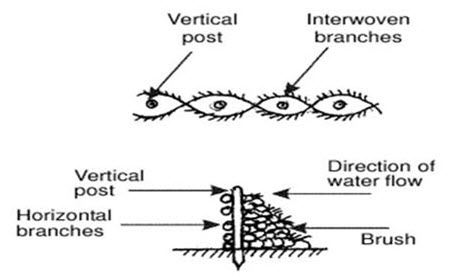
Fig. 28.5. Vertical and side views of single row check-dam. (Source: http://www.bebuffered.com/downloads/ManualonGullyTreatment_TOTFinal_ENTRO_TBIWRDP.pdf)
2. Double Row Brushwood Check-Dam
This type of brushwood check-dam is suited where the rate of runoff is less than 1 m3/sec. The construction of the dam starts with an excavation in the floor and into the sides of the gully to a depth of 0.3-0.5 m. Two rows of posts, 5-10 cm in diameter and 1-2 m in length are placed into the holes, across the floor of the gully to a depth of 0.5-0.6 m. The spacing between the posts is 0.5 m. Brushwood or branches are packed between the posts. The height of the posts in the center should not exceed the height of the spillway otherwise the flow will be blocked and water may be forced to move to the gully sides. Fig. 28.6 shows the double row brushwood check dam.
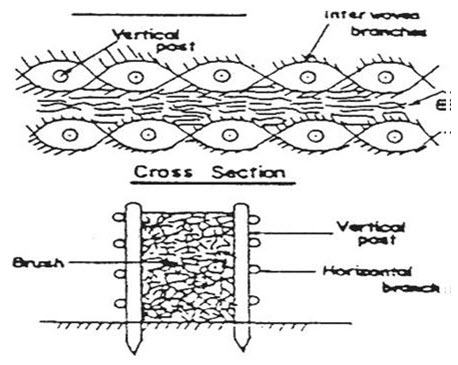
Fig. 28.6. Double row brush wood check-dam. (Source: http://www.bebuffered.com/downloads/ManualonGullyTreatment_TOTFinal_ENTRO_TBIWRDP.pdf)
28.7 Specifications for Brushwood Check-dams
The choice for post brush check-dam must be made after careful examination of material availability in the near vicinity. Otherwise, problem of cutting all the sparse vegetation in the area would bring in undesirable results.
Brush wood check-dams particularly single rowed ones can be strengthened with bamboo mat or sand filled bags on the upstream part to serve as a shock absorber and to dissipate the runoff energy during pick flows.
Any tree or shrub species can be used as posts. But the wooden posts should be rot resistant and termite proof. The brushwood must not be very dry and easily breakable.
To avoid the brushwood being removed by flowing water, it is necessary to fix the brushwood with rope, wire or nail.
The ends of interlink materials should enter at least 30 cm into the sides of the gully.
The space behind the brushwood check-dams must be filled with soil to the spillway, if either sand bag or bamboo mat is not used.
If sprouting species (salix and popular) are selected as posts and interlink materials, brushwood check-dams should be constructed when the soil in the gully is saturated or during the early rainy season.
If non-sprouting species are used as strips and interlink materials, brushwood check-dams can be constructed during any season
Reference
https://energypedia.info/images/a/aa/GullyReshapingRevegetation.png
http://www.bebuffered.com/downloads/ManualonGullyTreatment_TOTFinal_ENTRO_TBIWRDP.pdf
Suggested Reading
http://www.bebuffered.com/downloads/ManualonGullyTreatment_TOTFinal_ENTRO_TBIWRDP.pdf
http://www.coralreef.gov/transportation/sederosuvi.pdf
http://www.fao.org/docrep/006/ad082e/AD082e03.htm
http://www.forestrynepal.org/wiki/346
http://info.water.gov.my/attachments/article/324/GuidelineCheckDamsCompleteSet.pdf